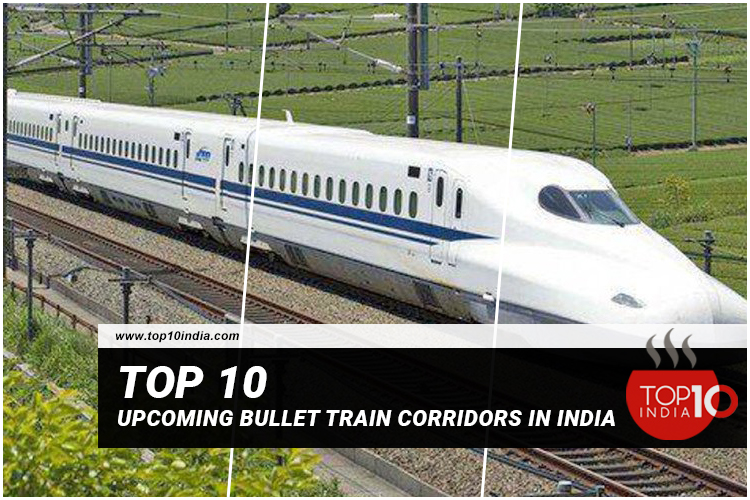Top 10 Upcoming Bullet Train Corridors In India: Mumbai Ahmedabad high-speed rail corridor is the number 1 upcoming bullet train corridor in India that is going to make travel more quick and comfortable. A bullet train is a train that travels at a speed of more than 250 kilometers per hour. Japan created the first of its sort to connect several Japanese regions with Tokyo. India currently lacks the technological developments necessary to build a bullet train on its own. Japan has provided total technical assistance and more than 80% financial support for the first bullet train project between Mumbai and Ahemdabad. Once the trains are operational, traveling longer routes in less time will be easier, providing an alternative form of transportation to relieve traffic congestion on the roads and highways.
Top 10 Upcoming Bullet Train Corridors In India
Interstate traffic would increase as the speed of bullet trains increased, giving a boost to diverse companies within cities. Railways would be a little less congested if they didn’t have to transport such a large number of people.
Prime Minister Narendra Modi and Japanese Prime Minister Shinzo Abe lay the foundation stone for the bullet train project connecting Mumbai and Ahemdabad in September 2017. Since then, the Indian government has sanctioned a slew of similar projects along other routes. Take a look at all of the proposed and ongoing routes in our article top 10 upcoming bullet train corridors in India.
No 1. Mumbai–Ahmedabad High-Speed Rail Corridor
The Mumbai-Ahmedabad route is a 508-kilometer length that is currently under construction. The government took the maximum amount of time to purchase the land, but the project is now on the verge of completion. For the Ahmedabad-Mumbai High-Speed Rail Corridor, Indian Railways recently received all-important wildlife, forestry, and coastal regulation zone permissions in Gujarat and Maharashtra.
By June 2022, the project should be completed. Mumbai–Ahmedabad The High-Speed Train Corridor is a high-speed rail line in India that connects Mumbai, the country’s financial capital, with Ahmedabad. It will be India’s first high-speed rail line when it is built.
No 2. Delhi–Varanasi High-Speed Rail Corridor
The Delhi-Noida-Agra-Lucknow-Varanasi route is an 865-kilometer corridor that runs from east to west across Uttar Pradesh, Delhi, and Haryana. The train would go at a minimum of 250 kilometers per hour. This line would include 12 stops, and property acquisition is currently underway.
He suggested high-speed rail connectivity between different cities along the corridor, the Delhi Varanasi High-Speed Rail Corridor is proposed to travel over major expressways, national highways, greenfield regions, and maybe arterial roads of the intermediate city road network.
No 3. Varanasi-Howrah High-Speed Rail Corridor
The Varanasi-Howrah Route is still in its early stages. It’s a 760-kilometer journey with Patna as a significant stop. NHSRCL’s projected train track would shortly commence land purchase, according to a recent procurement document posted by the National High-Speed Rail Corporation Limited.
The fare structure has yet to be established, although it is projected to be 1.5 times the present Indian Railways first class AC fare. Official fares, rates, and rules for the line are expected to be set closer to the start of commercial operations.
No 4. Mumbai–Nagpur High-Speed Rail Corridor
Another Maharashtra project is the Mumbai-Nashik-Nagpur highway, which spans 753 kilometers. This project is currently in the planning stages and has received PMO approval. he made the suggestion Mumbai For high-speed rail connectivity between cities along the corridor, the Nagpur High-Speed Rail Corridor is proposed to run through the Samruddhi Mahamarg Expressway, national highways, greenfield sites, and maybe along arterial roads of the intermediate city road network.
No 5. Mumbai–Hyderabad High-Speed Rail Corridor
The Mumbai-Pune-Hyderabad Route project is in its middle stages, and numerous private actors have stepped up to help. The train would cover a distance of 711 kilometers as part of this project. Ashok Chavan demands the construction of a Mumbai-Hyderabad bullet train through Marathwada.
Ashok Chavan, the minister of public works, has urged that the state provide a connection for the projected high-speed rail track between Mumbai and Hyderabad through the Marathwada region.
No 6. Chennai–Mysuru High-Speed Rail Corridor
The Chennai-Bengaluru-Mysuru project would stretch for 435 kilometers. The NHAI is collaborating with NHSRCL to construct a railway line along this route. The initiative was just introduced and is currently in its first phase. It is being built along two major railway lines in southern India. On the same route, a Chennai-Bengaluru highway is being planned.
The project is projected to reduce the time it takes to travel from Mysuru to Chennai to two and a half hours. The Shatabdi Express, the fastest train on the route, takes seven hours to get there right now. The trains will stop in Mandya, Channapatna, Bangarpet, Chittor, Arakkonam, and Poonamallee, among other places, in addition to Bengaluru.
No 7. Delhi–Amritsar High-Speed Rail Corridor
The 459-kilometer Delhi-Chandigarh-Ludhiana-Jalandhar-Amritsar route includes key stations such as Jalandhar and Chandigarh. For the time being, the government has prioritized this project. The Delhi-Amritsar high-speed rail track, which would connect Ludhiana along the way, promises to cut travel time between the national capital and Amritsar by more than half. NHSRCL has yet to offer details on the corridor and all of the stations it will pass through.
No 8. Patna–Guwahati High-Speed Rail Corridor
Bullet trains will be introduced along select high-density passenger routes designated in the draught NRP. A new bullet train line between Patna and Guwahati via Katihar and New Jalpaiguri has been inaugurated. Guwahati would be connected to the Delhi-Agra-Kanpur-Lucknow-Varanasi bullet train line with this new corridor. The Draft National Rail Plan has been released by the Ministry of Railways (NRP).
By 2021, various cities across India would be connected by bullet trains, according to this proposal. The draught NRP proposes that existing bullet train tracks be extended and new ones are added to the high-speed rail map to include key cities with tourism and economic potential.
No 9. Hyderabad-Bengaluru High-Speed Rail Corridor
Several cities throughout India, including Hyderabad, will be connected by bullet trains by 2051, according to the Indian Railways’ new draught National Rail Plan (NRP), which was announced on Friday. The news follows the National High-Speed Rail Corporation Limited’s (NHSRCL) announcement of tenders for the preparation of Detailed Project Reports (DPR) for the Mumbai-Pune-Hyderabad bullet train project.
By extending the Mumbai-Hyderabad line envisaged previously, the draught NRP aspires to build a corridor between Hyderabad and Bengaluru.
No 10. Chennai–Kanniyakumari High-Speed Rail Corridor
NHSRCL is building a high-speed bullet train between Ahmedabad and Mumbai, which is worth mentioning. The proposed corridor measures 508.17 kilometers in length. The Mumbai Ahmedabad High-Speed Rail will cross two states, Maharashtra and Gujarat, as well as one Union Territory, Dadra and Nagar Haveli.
The Ministry of Railways has already submitted a proposal to the Cabinet for approval. Permission to perform a feasibility study is requested in the proposal. A detailed project report (DPR) for ten proposed bullet train corridors across India is also included.
FAQs
Which Bullet Train will run in India?
Mumbai Ahmedabad Bullet train will run in India.
Which is the fastest train in India 2021?
Shatabdi Express is the fastest train in India 2021.
Which country will help India in the bullet train project?
Japan will help India in the bullet train project.























Be First to Comment